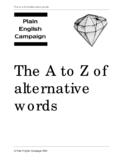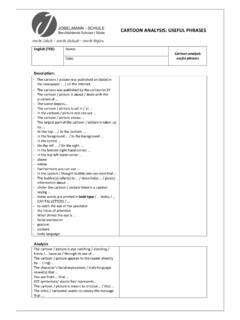Transcription of AN IRISH-ENGLISH DICTIONARY, BEING A THESAURUS OF …
1 FOCL IR GAEDHILGE AGUS B ARLA. AN IRISH-ENGLISH DICTIONARY, BEING A THESAURUS OF THE. words , phrases AND IDIOMS OF THE MODERN IRISH LANGUAGE, WITH EXPLANATIONS IN ENGLISH. COMPILED AND EDITED BY REV. PATRICK S. DINNEEN, DUBLIN: PUBLISHED FOR THE IRISH TEXTS SOCIETY BY. M. H. GILL & SON, LTD., 150 UPPER O'CONNELL STREET. THE GAELIC LEAGUE, 24 UPPER O'CONNELL. STREET. LONDON: DAVID NUTT, AT THE SIGN OF THE PHOENIX, 57-59 LONG ACRE. 1904. PRINTED BY. SEALY, BRYERS AND WALKER, MIDDLE ABBEY STREET, DUBLIN. COUNCIL'S PREFACE. THIS Dictionary of the modern Irish language, with explanations in English, is the outcome of a project conceived a few years ago by the members of the Council of the Irish Texts Society. On the initiation of Mr. G. A. Greene, , then Vice-Chairman of the Council, they decided to compile, with the assistance of Irish speakers and scholars throughout Ireland and Great Britain, and under the direction of competent Editors, a small IRISH-ENGLISH Pocket Dictionary for the use of students of the modern tongue.
2 As a foundation for this work, about 12,000. words were collected from existing glossaries, from the spoken language and from modern writings, and sorted into slip form. The Editors who were asked to carry out the task of editing this material, Father O'Leary and Mr. David Comyn and, at a later stage, Mr. John MacNeill, found themselves, through the pressure of other work, unable to fulfil their intention, and the help of Father Dinneen was eventually secured. In carrying out his views as Editor, Father Dinneen found it necessary to make many alterations on the slips handed to him, involving labour which would not have been incurred had he been appointed in the first instance. Indeed, Father Dinneen has so amended and expanded the fragmentary materials submitted to him, that the present work may be regarded as practically his creation, and the Council gladly acknowledges its indebtedness to him for bis severe and patriotic labours in bringing the work to a satisfactory conclusion.
3 The members of the Council wish to add their own sincere thanks to those of the Editor to all those gentlemen who have assisted the undertaking, either by reading proofs, or by the compilation of lists of local words , or by personal assistance rendered in different ways to the Editor. The names of those who have given financial aid will be found at the end of the volume. These marks of kindness and interest in the work have been of the greatest service, and have afforded much encouragement both to the Council and to the Editor. Signed on behalf of the Council, DOUGLAS HYDE, , President. DANIEL MESCAL, Chairman. ELEANOR HULL, Hon. Secretary. EDITOR'S PREFACE. THE study of the Modern Irish Language, which has received such an impetus in recent years, has been greatly hampered by the want of a convenient lexicon. Nothing but the urgent necessity that existed for such a lexicon could have induced me to abandon more congenial studies and devote my energies to the development and completion of the work so laudably undertaken by the Council of the Irish Texts Society.
4 As I proceeded with the revision of the material supplied me the work grew imperceptibly under my hands. In preparing the work, I. went through the whole of Peter O'Connell's MS. Dictionary, and also, though more rapidly, through the MS. Dictionary compiled by O'Naughton. The Gaelic Journal and the principal modern published texts were also laid under contribution, as well as several lists of words received from various parts of the country Not the least valuable part of the work is what I was able to remember from the days of my childhood, the rich vocabulary employed by my father and mother and the inhabitants of my native Sliabh Luachra, the snatches of song, of story, of proverb, the allusions and rhymes and exclamations which mingled with their conversation, as well as the precise and accurate use of phrase and idiom which distinguished them.
5 In spite of many defects, it is claimed for this work that it contains a larger number of words used in the living Irish language and in the more modern written compositions than any Irish Dictionary yet published; that it gives the various words fuller grammatical treatment; that it explains them more in detail and with greater precision and accuracy; that it gives a fuller account of local usage and pronunciation; that it treats more fully the more important words which form the basis of the main idioms that constitute the core of the language; that it gives a greater number of peculiarly poetical expressions; a fuller list of technical words and a more copious supply of examples drawn from the living speech of the people; that it has a more abundant list of references to modern standard works; that it deals more exhaustively and with fuller illustration with the various particles whose uses and functions are calculated to puzzle the student.
6 It is claimed that the book gives a fairly accurate explanation in English of the main stream of words , idioms and forms that constitute the Modern Irish Language. Absolute completeness, either in the list of words or in the idioms, is not claimed, the time and space limits and other circumstances affecting the production of the work rendering such completeness impossible. In the insertion of compound words , which form an important factor in the language, space had to be economized. It is obvious that in an unsettled language like Irish, which has not been cultivated to any extent since the use of print became general, many orthographical difficulties present themselves to the lexicographer. Complete uniformity of spelling is certainly a great desideratum. Indeed, it is impossible to conceive a flourishing literature in an age of printing like the present without a uniform orthography of some kind.
7 The science of grammar becomes a mockery where there is not some show of uniformity in the written forms of the words , and students of the language are disheartened by an unsettled and ever varying orthography. The circumstance that the language has been growing apace, as all languages grow, for the last couple of hundred years, without in many parts of the country the check of a written or printed literature, has resulted in its forming itself into two or three more or less clearly defined dialects which differ from one another in several points. The Irish spoken in the Extreme North of Ireland differs from that spoken in Munster, and that spoken in Connaught differs from both. The Irish of South Connaught approaches that of Munster, while that of North Connaught resembles that of Ulster. As regards the orthography employed, perhaps the only item that will seem somewhat radical is the uniform use of sc, sp, st, in preference to sg, sb, rd, respectively, but especially the use of sc for sg.
8 On this point it may be observed that these sets of letter-combinations in general follow the same law, and that it is desirable to adopt a uniform system. In our books and dictionaries there is great confusion between the combinations sc and sg, and the time seemed to have come for writing uniformly one or the other. The question was, which should be selected. The selection of sc is only the natural lexicographical evolution. O'Naughton, the author of our earliest modern dictionary (finished 1727), writes sc for the most part, and devotes only a few pages to words beginning with sg. O'Brien (1767) states in his dictionary that sc and sg are absolutely identical, and that words spelled with sc will not be repeated under sg. O'Reilly made much the same observation, while Peter O'Connell (1826), whose work is most laborious, systematic, and comprehensive, writes sc in, every case.
9 Of the living authorities who were consulted on this question opinion was divided. I may mention that Dr. Standish Hayes O'Grady, Professor Strachan, and Dr. Joyce, approved of the exclusive use of sc, while Father Peter O'Leary, Mr. Bergin, Mr. Lloyd, and others, favoured sg. There can be no question, of course, that sg is far more common in modern manuscripts, and up to a recent date at least was more common in books. As regards the sound of the language used at the present day opinion also differs, some maintaining that the sound after s is g, and others that it is c. I think that the sound is in many cases sc, and in most other cases approaches nearer to sc than to sg. It seems to me that in words like sc al, sc imh, scilling, where sc is followed by a slender vowel, the s is more affected than the c, the s becomes sh rather than c g.
10 This sh sound of s, I believe, makes many think that a g-sound and not a c-sound is heard. In words like scoil, to my ear at least, the sound is c. With regard to plural forms like p istidhe, which some now write p ist , and pr taidhe, which they write pr ta , only the longer form is given in these pages. That form is given as BEING the best established, though it is undoubtedly cumbrous and awkward to a degree. Both forms would have been given except that it seemed a needless waste of space to do so, and hence the exclusion of the shorter form is not to be regarded as prejudicing its claims. There can be no doubt that the tendency will always be in the direction of retrenching unsounded letters, and making the spelling square with the pronunciation. But the process must be gradual and, as it were, imperceptible. The diphthong a has been used throughout instead of eu.








